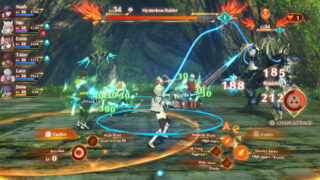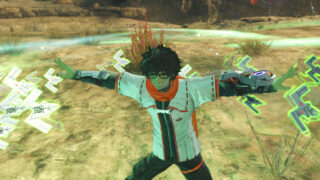Review: Xenoblade Chronicles 3 continues Switch’s incredible JRPG run
Kiss your free time goodbye as Monolith Soft serves up its largest – and most story-stuffed – world yet
- Executive director
- Tetsuya Takahashi
- Key Credits
- Koh Kojima (Director), Genki Yokota (Director)

Final Fantasy 16 producer, Naoki Yoshida, reckons it’d take 15 years to build an open-world FF, what with the effort required to execute their level of cinematic storytelling at that kind of scale.
Right on cue, here comes Monolith Soft, with a 140-hour bruiser of a JRPG – its fourth in 12 years. Xenoblade Chronicles 3 shows us that satisfying storytelling, embedded in a vast, not-quite-open world is doable. Though how the studio works at this rate is as big a mystery as any raised in the game’s tale of warring nations and their puppet masters.
Okay, there’s some false equivalence at play there: by working on Nintendo’s more humble hardware Monolith Soft isn’t slave to the resource-gobbling photorealism that has slowed so many of our favourite series this last generation. From XC1 on Wii, it realised that art design and concept could trump raw heft, leading to Xenoblade’s dependance on worlds set on the backs of titanic beasts. The dizzying scale of limbs and jaws blotting out the skies easily distracted from fuzzy textures and pop-in.
In XC3 this landscape is Aionios, a ring of land encircling an impassable vortex. There’s no monster beneath your feet and that limits the initial wow factor – no individual area is as conceptually funky as XC2’s swarm of jellyfish, say. Instead, it settles for awesome size and vistas that stretch far beyond the older games (and with better TV and portable performance to boot). While the world is still partitioned with loading between regions, it takes a lot longer to hit those boundaries, with a lot more variety packed within them.
Take one region, Fornis. As dry canyons segue into grassy hills (this game’s answer to XC1’s Gaur Plain) you’re able to turn from the grazing Armus to see the towering military colony you liberated hours before. And that’s without factoring in its miles of cave networks or an entire desert that spreads out to the side of both. The game’s standout area takes this even further: handing you a boat to explore an ocean scattered with islands, prisons and hidden inlets. It’s Xenoblade does Wind Waker, only the ship here is mercifully faster.
Monolith also does a cool trick where something you assumed was background scenery is revealed to be part of the explorable world, often tens of hours after you’ve passed it. At first glance, Aionios’ jungle is a linear journey along vines between abandoned skyscrapers. The closest thing we’ll see to Horizon on Switch, but fairly normal. But the vast abyss that gobbles up clumsy explorers does have a bottom, and discovering how deep the rabbit hole goes, and how interconnected the warren is, serves up constant a-ha moments.
It’s elevated, too, by the eyes through which the world is seen. At the outset, our six heroes are on rival sides of an eternal war between the nations of Keves and Argus. Spoiler alert: they are soon united with a common cause. But as much as that story, and its pantomime villains, motivate you to proceed, the real pull is watching teenagers bred for war learning to appreciate the possibilities of life outside of it. They are seeing the world for the first time, and the shared excitement of exploration creates a tight bond with them.
And where previous Xenoblade games maybe struggled to hide the breadcrumb trail that dragged you to every corner of the world, XC3 also finds more meaningful ways of filling a map with adventures. This is as much the tale of the wider armies, represented by colonies and their colourful commanders, as it is the central sextet.
Liberating other soldiers invites you into their worlds, revealing problems specific to certain regions or stemming from the philosophical outlooks that govern their platoons. Finding a new home for a team of brainwashed stealth assassins has a very different vibe to solving a potato famine or earning the respect of a renowned strategist by teaching his hopeless troops. Optional stories paint a much fuller picture than any Xenoblade before.
So while it maybe smacks of Ubisoft map-filler to be told to find and free these bases in your spare time, they are stuffed with tangible rewards, and make up a lot of that hulking 140-hour runtime. At the very least they unlock extra heroes, who take a seventh place in your party and add job classes for the central six to learn. But performing further favours also lets you sniff out mini soap operas unfolding in each camp, and eventually undertake a mission that ‘completes’ the heroes’ stories and unlocks the level cap on their job class.
“While it maybe smacks of Ubisoft map-filler to be told to find and free these bases in your spare time, they are stuffed with tangible rewards, and make up a lot of that hulking 140-hour runtime.”
As a mechanical boon, this is essential to getting the most out of Xenoblade 3 – more on that in a second – but the tales are strong enough by themselves. Where side quests in previous games were lumbered with wooden storytelling, these bigger hero arcs are fully voiced and performed, with some of the game’s wildest boss encounters hidden within. Then beyond that, there’s even weirder stuff to deepen your affinity with the colonies: a potato PR campaign, mech hijacks, birthday parties and more. It’s truly stacked.
Something we love about the Xenoblade games is how tightly they weave stories and systems together. In XC1 that was a sword that saw the future and offered portents of doom in battle; in XC2 it was living weapons: you explored their tragic lives at the same time you bonked people over the head with them. Xenoblade 3 has a couple of examples: the class system, in which advancing your allies’ stories improves the jobs you learn from them, and the ouroboros, a superhuman form that bonds two of the six together.
In a game where you take real-time control over a single hero, the class system gives combat a huge dose of variety. In the moment-to-moment there’s the fun of mastering a specific role: just amongst the aggro-drawing defenders you’ve got a type that leans on evasion, one that soaks up damage to strengthen attacks and another that becomes a countering powerhouse when near injured friends. All require different positioning and move timing – a good thing you’ve got 100+ hours to learn them all.

But when you start mixing up classes it becomes a whole new thing entirely. Now you’re plugging gaps in one moveset with abilities from another, or trying to match more passive underlying skills to supercharge your build. Crucially, moves you inherit between classes are limited to a handful; that may disappoint some number crunchers, but it makes the system welcoming and, once you’ve factored in 20+ classes you can mix up, still vast enough to keep you tinkering for hours.
To give an example, a personal favourite melded the gunslinger class with a stealth archer, using the latter’s aggro-lowering moves to soften the vast damage output of the former, while also plugging in directional attacks that are used in tandem – a ‘fusion’ attack’ – to maximise every bullet up a monster’s backside. If that sounds like nonsense, don’t worry: Monolith drip feeds this beautifully and will get anyone up to speed.
Interestingly, there’s one class that gives you granular control over building your ideal fighter, but the surprise of that is best left for you to discover. That something so game-changing is buried in an optional quest is an indicator of Monolith’s confidence in its core system.
“Where side quests in previous games were lumbered with wooden storytelling, these bigger hero arcs are fully voiced and performed, with some of the game’s wildest boss encounters hidden within.”
And let us not forget, this is just one character. You have six in the party to tweak, letting you discover crazy synergies. This is obviously the bread and butter of RPG party composition, and may not sound evolutionary, but it’s rarely done with this kind of speed or ease: it’s immediately obvious if you’re under or overcompensating with the general make-up of the squad. Health bars never dip, but fights take an age? Dial back on medics. Multiple enemies overwhelming you? Split them with more defenders. As someone who tends to find a group and stick to it, I was impressed by how XC3 drew me into this wider configuration.
Those hoping to take precise control over the six during fights may be disappointed. While you can hop between party members in combat – a first for the series – the manic speed of battle doesn’t make this viable: there’s no indicator of what arts they have primed at any given time, or whether they are sitting on a Talent Art – which is a super move that charges by performing actions true to the role (healing as a healer, etc). So it’s best used for taking direct control of a medic if you want to heal a specific ally, say.
This isn’t a problem. Even playing on hard, the party AI easily kept up – medics are particularly good at prioritising defenders before safely helping attackers – and you can give orders to focus attacks, deploy fusion moves (that power up the ouroboros) or pursue certain combos – a classic Xenoblade feature that lets you break, topple and daze enemies before launching them for massive damage or ‘bursting’ them to get a scatter of rare items in the middle of battle. Once again: all this is very smoothly introduced.
The ouroborus forms are the piece of the combat puzzles we’re least sold on: a superpowered suit that briefly replaces your moveset with giant attacks. Like everything in XC3 they are customisable through their own skill trees, but for a long time they burn up fuel at such a rate that they’re gone in a flash. Also, compared to building your dream bespoke class, the suits feel lumbering and broad. They commit the videogame sin of seeming so much more capable in the cutscenes.
It’s not a dealbreaker: they are a tiny part of a huge combat collage, where every technique seems to feed into another. And even these clumsy brutes get their moment in the sun: fully levelled up they have more time on their hands to unleash beatdowns, and they also act as the finisher in a chain attack – the one moment combat is paused and you are free to pick everyone’s next move with precision. Getting to the end of a gruelling boss fight, punchdrunk and in the red, and releasing a giant robot thump is pretty good.
And if the suits never quite take off under your thumbs, they’re a cool device in the grander story, which is in itself one of the best in the series. We noted in an earlier preview that it felt soulful compared to Xenoblade 2’s more hyperbolic anime stylings and that’s largely true for the whole: the villains are slightly goofy, and weaker for there being so many of them – no kidding, you’ll deck a whole alphabet’s worth by the end – but it’s countered by nuanced characterisation in the party, a story that gives all six a moment to shine and an ending that is quietly devastating. Or maybe that was just the 140 hours catching up with us.
As for whether you need to play earlier games? The Xenoblade series tell standalone stories – with proper beginnings, middles and ends – but have underlying lore ties for returning fans. Those links are definitely more explicit in XC3, but it’s still fully comprehensible for the newcomer. If you have played XC1 and 2, however, there are a couple of punch-the-air moments to look forward to. Is it dumb to get teary-eyed at a music callback? Feel no shame. Oh, and definitely play beyond the end credits for some vital fan service.
And so continues one of the great JRPG success stories of the last ten years. A genre that simply grown too unwieldy for many to make, tamed and mastered by the potent combination of Monolith Soft’s pedigree and Nintendo’s quality control. As others wrestle with scale and story, Xenoblade Chronicles 3 pulls it off it with sweetness, sincerity and style.
Xenoblade Chronicles 3 delivers a massive world, and more than enough story and character to fill it, combined with the series’ most reactive combat system to date. While certainly a monster commitment, Aionios is an incredible place to live for a month or two.
- Class-driven combat is perfect mix of accessibility and depth
- A huge cast of likeable heroes to meet and recruit
- Another killer Yasunori Mitsuda/ACE soundtrack
- Vast amount of ideas carefully introduced and tutorialized
- Series fans get more connective tissue to enjoy this time
- The suits feel lumbering and broad






















